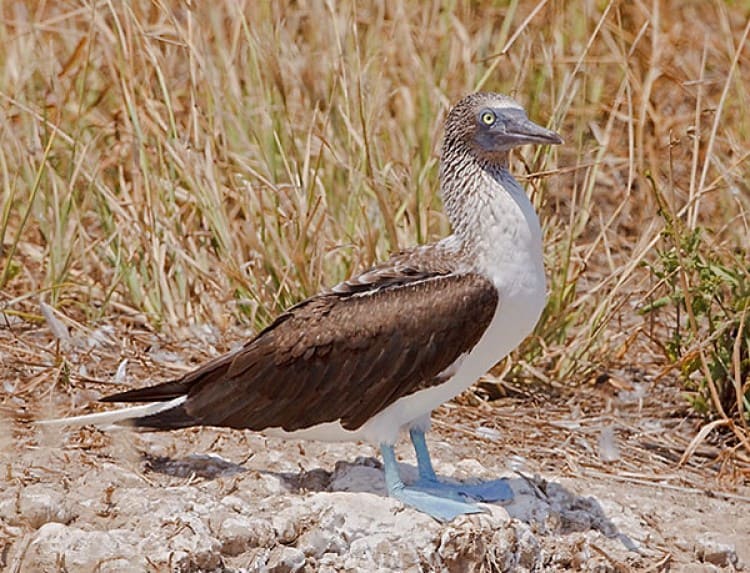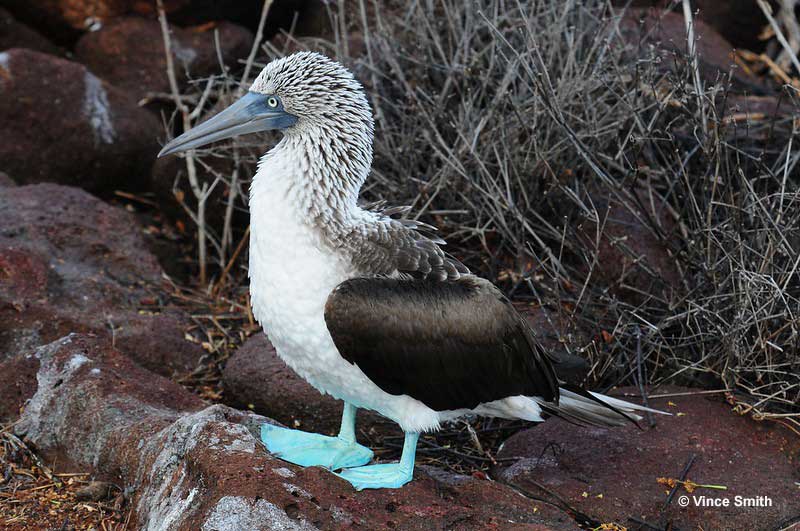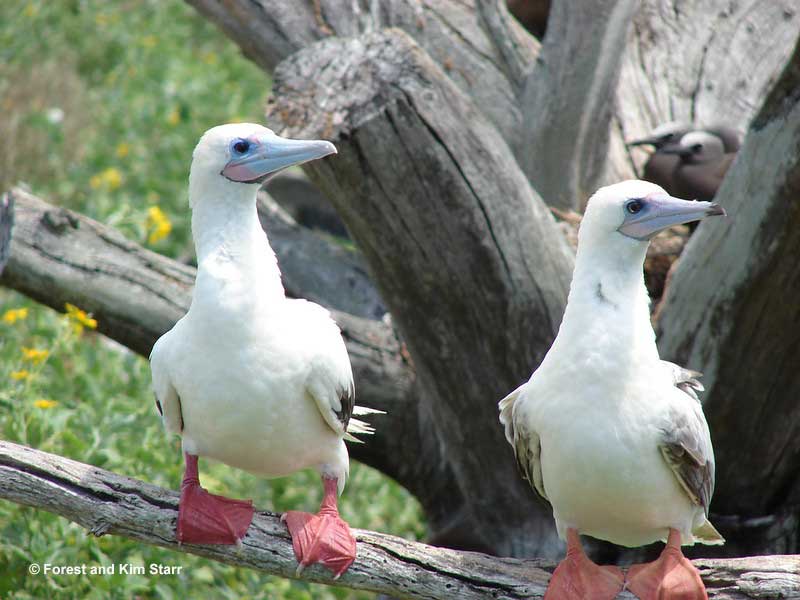The Blue-footed Booby (Sula nebouxii) stands out amongst other marine birds with its striking azure feet and captivating courtship dances.
Distributed along the continental coasts of the eastern Pacific Ocean, from the sun-kissed shores of the Gulf of California to the iconic Galápagos Islands and the coastal stretches of Peru, the Blue-footed Booby thrives as a strictly marine bird, returning to shore only to reproduce. There is much to discover about them!
On this page
Identification
Blue-footed Boobies are large birds, measuring approximately 28 to 34 inches in length, with a wingspan of about 57 to 65 inches. They have a long, dagger-like bill, long, narrow, and pointy wings, and a relatively long tail.
Male and female Blue-footed Boobies can be challenging to differentiate at first glance, as they have the same appearance. However, if they’re side by side, then the slightly larger ones are the females and the smaller ones are males.
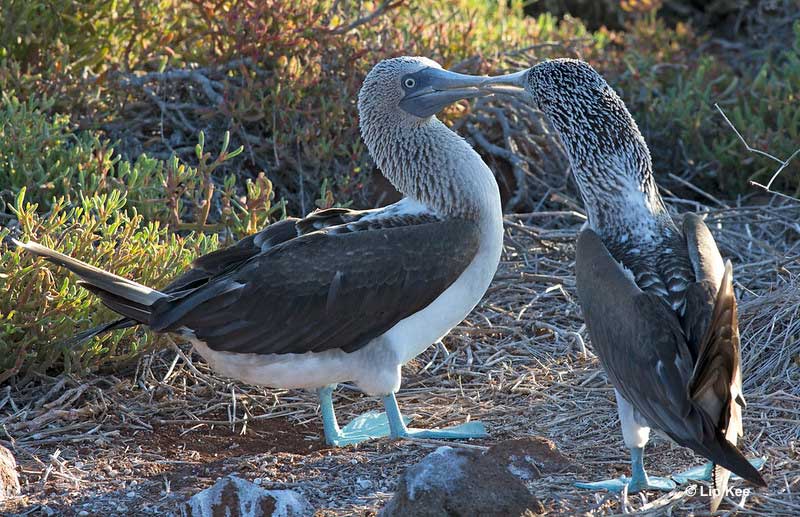
Females tend to be larger in size. © Lip Kee
Adult Blue-footed Boobies have primarily brown back and wings, white underparts, and a white head and neck streaked with light brown.
As the name suggests, they have bright blue webbed feet. The intensity of the blue color varies, but it tends to be quite vibrant. They have a pale blue-gray beak that is long and pointed, and their eyes are yellow.
Immature Blue-footed Boobies are darker than adults. Their upperside is almost completely brown except for some white mottling on the back, the underside of their body is white, and the underside of their wings is dark. Unlike adults, they do not have blue coloration. Their bills and feet are black.
Blue-footed Boobies are usually silent unless it’s the breeding season.
At sea, they are rarely vocal, except during prey squabbles. When nesting, males emit whistling, and females and young hoarse quacking or trumpeting sounds.
Food
Blue-footed Boobies’ diet primarily consists of fish, but they may also eat squid. They go for small schooling fish such as sardines, mackerel, anchovies, flying fish, and others.
Females are larger, hunting larger fish and diving deeper, whereas the males are smaller, have larger tails, and are better adapted to catch smaller fish at shallower waters.
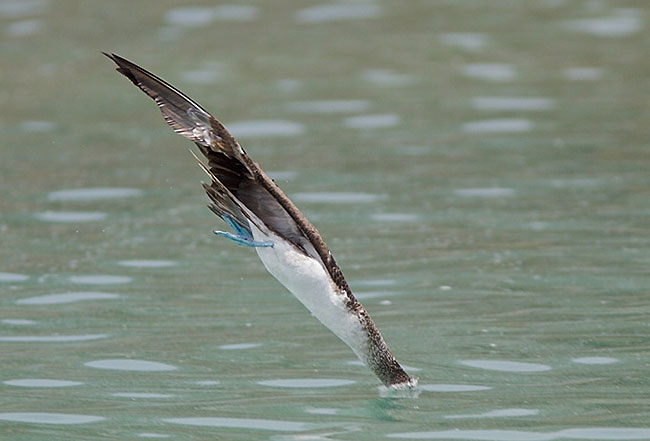
Photograph © Glenn Bartley
These birds hunt during daylight hours. They glide up to 80 feet above water and dive down to depths of 15 feet on average. The diving speed can reach up to 60 mph.
Although they often feed alone, they can also hunt in coordinated flocks. When one bird spots prey, it signals the rest with a whistle, and the entire flock dives down together like arrows. Upon diving, they resurface a few yards away with their catch, making minimal splashes.
Nesting and Eggs
Blue-footed Boobies are generally monogamous and breed when the conditions are suitable, which is about every 8-9 months.
Male Blue-footed Boobies defend small nesting territories and put on a display to attract females. During courtship, the male impresses the female by flaunting his blue feet, dancing, and presenting nest materials.
Both male and female Blue-footed Boobies display their feet and choose their mate based on the vibrancy of the feet. The pair then select the nest site together within the bounds of the territory.
Blue-footed Booby’s nest is a bowl-shaped depression on flat ground that may become surrounded by feces over time. The female then lays 1-3 pale bluish eggs. The incubation lasts for 41-45 days and both parents take turns. Since they lack brooding patches, they incubate the eggs with their feet.
Chick rearing is also shared. The male provides food in the earlier stages since he catches smaller fish, whereas the female becomes the provider when the chicks start demanding more food. If food is scarce, they will only feed the biggest chick to ensure that at least one survives. The young stay in the nest for about a month.
Current Situation
The Blue-footed Booby ranges along the eastern Pacific Ocean’s continental coasts, stretching from the Gulf of California to the Galápagos Islands and south to Peru.
This marine bird’s primary habitat is strictly the ocean. It only needs the rocky coasts of the eastern Pacific Ocean for breeding and raising its young.
Blue-footed Boobies are listed as of least concern on the IUCN Red List, with a population of about 90,000 mature individuals and decreasing. This decrease is attributed to food scarcity and climate change.
Facts
- The brightness and vibrancy of Blue-footed Boobies’ feet is an indicator of how healthy they are. The brighter the feet, the healthier the bird. This is also why these birds select their mate based on the vibrancy of their feet.
- Blue-footed Boobies are able to dive up to 80 feet below the surface of the water. The pressure at this depth is quite high which is why they have evolved so that they have special air sacs in their skulls that protect them from it.
- Female Blue-footed Boobies are inclined to maximize their lifetime reproductive success. In times of food scarcity, the female will favor male chicks because they require fewer resources to survive and grow properly.
- Blue-footed Boobies have a brood hierarchy where the one that hatches first is the dominant one. If there’s a food shortage, the elder chick may peck the younger one and/or control its access to food their parents bring, occasionally resulting in the younger one’s death.
Similar Species
Although unique looking, the Blue-footed Booby has a few similar species from the Boobie family. We have described four of them and how to tell them apart. The main difference lies in the color of their feet. However, since they’re not always visible, we’ve also included other information.
Brown Booby
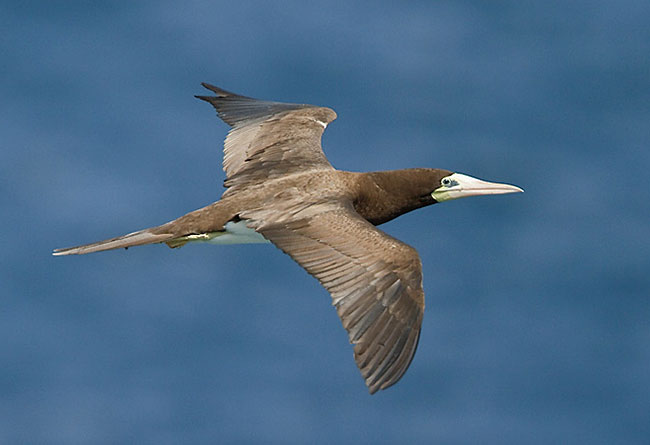
Brown Boobies are darker than Blue-footed Boobies. Their neck is solid brown instead of white and streaked, their bills are pale pink instead of dark, and their feet are yellow instead of blue. Immatures have a pale brownish belly instead of a white belly.
Red-footed Booby
Red-footed Boobies have two color morphs – light and dark. The Light morph has a pure white head, neck, back, and a part of its wings, whereas the Blue-footed Booby has a streaked neck and brown back and wings.
The dark morph is brownish all over and has a dark brown back and wings and a tan head, neck, and underside. Both morphs have red instead of blue feet and a blue instead of a dark bill.
Masked Booby
Masked Boobies have predominantly white plumage with a black face mask, tail, and flight feathers. Their bills are yellow instead of dark and their feet are also yellowish instead of blue.
Immatures are rather similar, but Masked Boobies have a paler bill and a distinctive white collar.
Northern Gannet
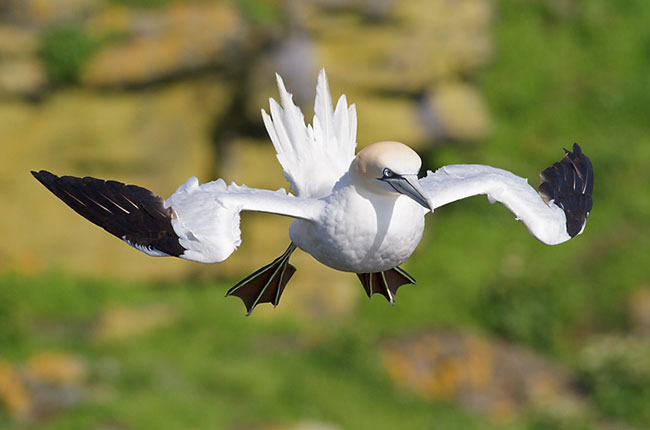
Adult Northern Gannets are predominantly white and do not resemble adult Blue-footed Boobies other than in shape and form.
However, immatures are quite similar, but Northern Gannets have a brown instead of a white belly.
Frequently Asked Questions
Are Blue-footed Boobys rare?
Blue-footed Boobies are a rare sight in North America. However, they are listed as of least concern on the IUCN Red List and their population consists of about 90,000 mature individuals.
How many Blue-footed Boobies are left?
The IUCN Red List estimates that there are about 90,000 Blue-footed Boobies left.
Why are Blue-footed Boobies called boobies?
Blue-footed Boobies are called boobies because they are clumsy on the ground. It is thought that the name comes from the Spanish word “bobo” which means stupid.
Do boobies mate for life?
Blue-footed Boobies usually mate for life.

